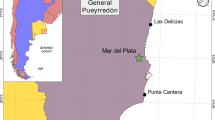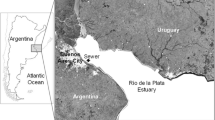Abstract
Dechlorane Plus (DP) and some of its possible degradation products were measured in eggs from the yellow-legged gull (Larus michahellis) and Audouin's gull (Larus audouinii) from a protected area in the southwestern Mediterranean Sea. Statistically significant differences were found between both gull species, with yellow-legged gull eggs showing the highest average total DP concentration (209 pg/g wet weight). According to stable nitrogen and carbon isotope values, variations in DP concentrations in the gull species studied are explained by foraging behavior and diet rather than by the trophic position. Both DP stereoisomers were quantified in all the samples studied, and a slight enrichment of the anti-DP could have occurred in both species. The quantification of anti-[DP-1Cl] only in ∼58 % of yellow-legged gulls support the hypothesis of a species-dependent factor influencing the bioaccumulation and/or biotransformation of Dechlorane-related compounds. This study reports on the first measurements of Dechlorane-related compounds in biota from the North African continent, contributing to the knowledge about DP environmental fate and distribution. In the light of our results, more research on differences in species-dependent bioaccumulation and biotransformation capabilities as well as ecological effects is encouraged in future Dechlorane-related compound studies.



Similar content being viewed by others
References
Hoh E, Zhu L, Hites RA (2006) Dechlorane Plus, a chlorinated flame retardant in the Great Lakes. Environ Sci Technol 40:1184–1189
Sverko E, Tomy GT, Reiner EJ, Li YF, McMarry BE, Arnot JA, Law RJ, Hites RA (2011) Dechlorane Plus and related compounds in the environment: a review. Environ Sci Technol 45:5088–5098
Xian Q, Siddique S, Li T, Feng YL, Takser L, Zhu J (2011) Sources and environmental behavior of Dechlorane Plus–a review. Environ Int 37:1273–1284
European Commission (2007) The European Commission report on potential alternatives to deca-BDE. At: http://ecb.jrc.ec.europa.eu/documents/ExistingChemicals/Review_on_production_process_of_decaBDE.pdf Accessed 17 Feb 2012
Sverko E, Reiner EJ, Tomy GT, McCrindle R, Shen L, Arsenault G, Zaruk D, Macpherson KA, Marvin CH, Helm PA, McCarry BE (2010) Compounds structurally related to Dechlorane Plus in sediment and biota from Lake Ontario (Canada). Environ Sci Technol 44:574–579
Guerra P, Fernie K, Jiménez B, Pacepavicius G, Shen L, Reiner E, Eljarrat E, Barceló D, Alaee M (2011) Dechlorane Plus and related compounds in peregrine falcon (Falco peregrinus) eggs from Canada and Spain. Environ Sci Technol 45:1284–1290
US Environmental Protection Agency (2004) Dechlorane Plus, CAS no. 13560-89-9, High production volume (HPV) chemical challenge program: test plan. At: http://www.epa.gov/HPV/pubs/summaries/dechlorp/c15635.pdf. Accessed 17 Feb 2012
Crump D, Chiu S, Gauthier LT, Hickey NJ, Letcher RJ, Kennedy SW (2011) The effects of Dechlorane Plus on toxicity and mRNA expression in chicken embryos: a comparison of in vitro and in ovo approaches. Comp Biochem Phys C 154:129–134
Wu JP, Zhang Y, Luo XJ, Wang J, Chen SJ, Guan YT, Mai BX (2010) Isomer-specific bioaccumulation and trophic transfer of Dechlorane Plus in the freshwater food web from a highly contaminated site, South China. Environ Sci Technol 44:606–611
Tomy GT, Pleskach K, Ismail N, Whittle DM, Helm PA, Sverko E, Zaruk D, Marvin CH (2007) Isomers of dechlorane plus in Lake Winnipeg and Lake Ontario food webs. Environ Sci Technol 41:2249–2254
Zhang XL, Luo XJ, Liu HY, Yu LH, Chen SJ, Mai BX (2011) Bioaccumulation of several brominated flame retardants and Dechlorane Plus in waterbirds from a e-waste recycling region in south China: associated with trophic level and diet sources. Environ Sci Technol 45:400–405
Burger J, Gochfeld M (2004) Marine birds as sentinels of environmental pollution. EcoHealth 1:263–264
Roscales JL, González-Solís JG, Muñoz-Arnanz J, Jiménez B (2011) Geographic and trophic patterns of OCs in pelagic seabirds from the NE Atlantic and the Mediterranean: a multi-species/multi-locality approach. Chemosphere 85:432–440
Kelly JF (2000) Stable isotopes of carbon and nitrogen in the study of avian and mammalian trophic ecology. Can J Zoolog 78:1–27
Roscales JL, Gómez-Díaz E, Verónica N, González-Sólis J (2011) Trophic versus geographic structure in stable isotope signatures of pelagic seabirds breeding in the northeast Atlantic. Mar Ecol Prog Ser 434:1–13
Boutton TW (1991) Stable carbon isotope ratios in natural materials: II. atmospheric, terrestrial, marine, and fresh-water environments. In: Coleman DC, Fry B (eds) Carbon isotope techniques. Academic, San Diego, pp 173–184, Chapter 11
Fisk AT, Hobson KA, Norstrom RJ (2001) Influence of chemical and biological factors on trophic transfer of persistent organic pollutants in the northwater polynya marine food web. Environ Sci Technol 35:732–738
Ricca MA, Miles AK, Anthony RG (2008) Sources of organochlorine contaminants and mercury in seabirds from the Aleutian archipelago of Alaska: inferences from spatial and trophic variation. Sci Total Environ 406:308–323
Braune BM, Donaldson GM, Hobson KA (2001) Contaminant residues in seabird eggs from the Canadian Artic. Part I. Temporal trends 1975–1998. Environ Pollut 114:39–54
Hebert CE, Weseloh DVC, Gauthier LT, Arts MT, Letcher RJ (2009) Biochemical tracers reveal intra-specific differences in the food webs utilized by individual seabirds. Oecologia 160:15–23
Furness RW (1993) Birds as monitors of pollutants. In: Furness RW, Greenwood JJD (eds) Birds as monitors of environmental change. Chapman and Hall, London, pp 86–143
Gauthier LT, Hebert CE, Weseloh DVC, Letcher RJ (2007) Current-use flame retardants in the eggs of herring gulls (Larus argentatus) from the Laurentian Great Lakes. Environ Sci Technol 41:4561–4567
Spanish Ministry of Agriculture, Food and Environment (2012) The Chafarinas Islands as a protected area. At: http://www.magrama.gob.es/es/organismo-autonomo-parques-nacionales-oapn/centros-fincas/centros/chafarinas.aspx. Accessed 3 July 2012. In Spanish
IUCN (2011) The IUCN red list of threatened species. Version 2011.2. At: http://www.iucnredlist.org. Accessed 17 Feb 2012
González-Solís J, Oro D, Jover L, Ruiz X, Pedrocchi V (1997) Trophic niche width and overlap of two sympatric gulls in the southwestern Mediterranean. Oecologia 112:75–80
González-Solís J (2003) Impact of fisheries on activity, diet and predatory interactions between yellow-legged and Audouin's gulls breeding at the Chafarinas Islands. Sci Mar 67:83–88
Mills JA, Ryder JP (1979) Trap for capturing shore and seabirds. Bird-Banding 50:121–123
Merino R, Bordajandi LR, Abad E, Rivera J, Jiménez B (2005) Evaluation of organochlorine compounds in peregrine falcon (Falco peregrinus) and their main prey (Columba livia) inhabiting central Spain. Environ Toxicol Chem 24:2088–2093
Muñoz-Arnanz J, Sáez M, Aguirre JI, Hiraldo F, Baos R, Pacepavicius G, Alaee M, Jiménez B (2011) Predominance of BDE 209 and other higher brominated dipheyl ethers in eggs of white stork (Ciconia ciconia) colonies from Spain. Environ Int 37:572–576
Logan JM, Jardine TD, Miller TJ, Bunn SE, Cunjank RA, Lutcavage ME (2008) Lipid corrections in carbon and nitrogen stable isotope analyses: comparison of chemical extraction and modelling methods. J Anim Ecol 77:838–846
Roscales JL, Muñoz-Arnanz J, González-Solís JG, Jiménez B (2010) Geographical PCB and DDT patterns in shearwaters (Calonectris sp.) breeding across the NE Atlantic and the Mediterranean archipelagos. Environ Sci Technol 44:2328–2334
Ramos R, Ramírez F, Sanpera C, Jover L, Ruiz X (2009) Feeding ecology of yellow-legged gulls Larus michahellis in the western Mediterranean: a comparative assessment using conventional and isotopic methods. Mar Ecol Prog Ser 377:289–297
Navarro J, Oro D, Bertolero A, Genovart M, Delgado A, Forero MG (2010) Age and sexual differences in the explotaition of two anthropogenic food resources for an opportunistic seabird. Mar Biol 157:2453–2459
Moreno R, Jover L, Munilla I, Velando A, Sanpera C (2010) A three-isotope approach to disentangling the diet of a generalist consumer: the yellow-legged gull in northwest Spain. Mar Biol 157:545–553
Chen D, Letcher RJ, Burgess NM, Champoux L, Elliott JE, Hebert CE, Martin P, Wayland M, Weseloh DVC, Wilson L (2012) Flame retardants in eggs of four gull species (Laridae) from breeding sites spanning Atlantic to Pacific Canada. Environ Pollut 168:1–9
Sun Y, Luo X, Wu J, Mo L, Chen S, Zhang Q, Zou F, Mai B (2012) Species- and tissue-specific accumulation of Dechlorane Plus in three terrestrial passerine bird species from the Pearl River Delta, South China. Chemosphere 89:445–451
Sanpera C, Ruiz X, Moreno R, Jover L, Waldron S (2007) Mercury and stable isotopes in feathers of Audouin's gulls as indicators of feeding habits and migratory connectivity. Condor 109:268–275
Ramírez F, Hobson KA, Wangensteen OS, Genovart M, Viscor G (2010) A physiological marker for quantifying differential reproductive investment between the sexes in yellow-legged gulls (Larus michahellis). J Exp Mar Biol Ecol 396:48–52
Muñoz-Arnanz J, Sáez M, Hiraldo F, Baos R, Pacepavicius G, Alaee M, Jiménez B (2011) Dechlorane Plus and possible degradation products in white storks. Environ Int 37:1164–1168
Wang D-G, Yang M, Qi H, Sverko E, Ma W-L, Li Y-F, Alaee M, Reiner EJ, Shen L (2010) An Asia-specific source of Dechlorane Plus: concentration, isomer profiles and other related compounds. Environ Sci Technol 44:6608–6613
Jia H, Sun Y, Liu X, Yang M, Wang D, Qi H, Shen L, Sverko E, Reiner EJ, Li YF (2011) Concentration and bioaccumulation of Dechlorane compounds in coastal environment of Northern China. Environ Sci Technol 45:2613–2618
Sverko E, Tomy GT, Marvin CH, Zaruk D, Reiner E, Helm PA (2008) Dechlorane Plus levels in sediment of the lower Great Lakes. Environ Sci Technol 42:361–366
Zhang Y, Wu JP, Luo XJ, Wang J, Chen SJ, Mai BX (2011) Tissue distribution of Dechlorane Plus and its dechlorinated analogs in contaminated fish: high affinity to the brain for anti-DP. Environ Pollut 159:3647–3652
Acknowledgments
Part of this research was funded by OAPN from the Spanish Ministry of Environment. We thank Reserva Nacional de Caza de las Islas Chafarinas, its director, and staff for their support during the sampling campaign. The authors also thank Inmaculada Calvillo for her technical support in the laboratory.
Author information
Authors and Affiliations
Corresponding author
Additional information
Published in the topical collection Emerging Contaminants in Biota with guest editors Yolanda Picó and Damià Barceló.
Rights and permissions
About this article
Cite this article
Muñoz-Arnanz, J., Roscales, J.L., Vicente, A. et al. Dechlorane Plus in eggs of two gull species (Larus michahellis and Larus audouinii) from the southwestern Mediterranean Sea. Anal Bioanal Chem 404, 2765–2773 (2012). https://doi.org/10.1007/s00216-012-6326-7
Received:
Revised:
Accepted:
Published:
Issue Date:
DOI: https://doi.org/10.1007/s00216-012-6326-7




